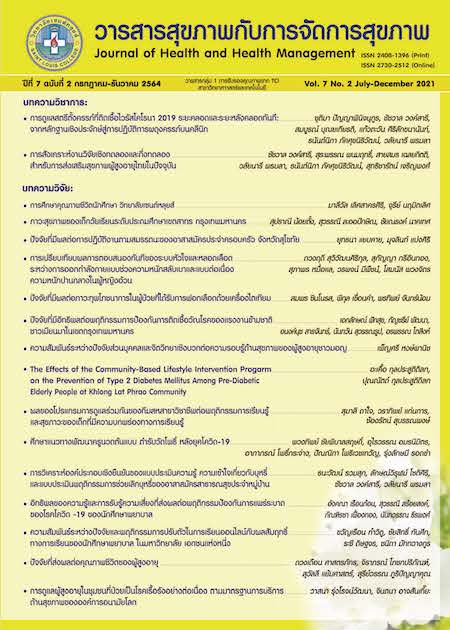Caring for Pregnant Women Infected with COVID19: Towards Developing Health Guidelines for Midwives In Thailand
Keywords:
pregnant women infected COVID-19, labor period and postpartum care, evidencesAbstract
Pregnant women who are infected with COVID19 tend to manifest symptoms of hypoxia. Such symptoms are more severe compared to those of uninfected pregnant women. Due to physiological changes during pregnancy in which the enlarged uterus squeezes the lung space, the expansion and gas exchange with the body becomes inefficient. It is also observed that during COVID19 infections, changes in blood coagulation occurs. COVID19 apparently provokes blood to easily clot. This is why pregnant women and their fetuses have a higher mortality rate than normal pregnant women. Various literatures argue that caring of a pregnant woman during labor and immediately postpartum periods has certain characteristics that practitioners must take care of in accordance within health guidelines. However, such guidelines are so numerous, diverse and vague that even the role of midwives remains unclear. To address this gap, this paper therefore reviews and compiles various evidences in existing literatures in the care of pregnant women infected with COVID19 in the hope of coming up with better guidelines the practicing midwives in Thailand.
References
กรมควบคุมโรค. (2564). แนวทางเวชปฏิบัติ การวินิจฉัย ดูแลรักษา และป้องกันการติดเชื้อในโรงพยาบาล กรณีโรคติดเชื้อไวรัสโคโรนา 2019 (COVID-19). ฉบับปรับปรุง วันที่ 17 เมษายน พ.ศ. 2564. สืบค้นจาก http://dmsic.moph.go.th/index/detail/8587
กรมการแพทย์. (2563). ประกาศกรมการแพทย์เรื่องวิถีใหม่ในการดูแลสตรีตั้งครรภ์ในห้องคลอดใน สถานการณ์การระบาดของโรคติดเชื้อไวรัสโคโรนา 2019 . สืบค้นจาก https://covid19.dms.go.th/backend/Content/Content_File/Covid_Health/Attach.
ชัชวาล วงค์สารี, และธนันต์นิภา ภัคศุขนิธิวัฒน์. (2559). บทบาทพยาบาลกับการจัดการดูแลหญิงตั้งครรภ์ที่ประสบอุบัติเหตุฉุกเฉิน.วารสารคณะพยาบาลศาสตร์ จุฬาลงกรณ์มหาวิทยาลัย, 28(1), 1-11.
พัชรินทร์ เงินทอง .(2564). คำแนะนำในการดูแลสตรีในระยะตั้งครรภ์ ระยะคลอดและหลังคลอดระหว่างการแพร่ระบาดโควิด-19: การทบทวนวรรณกรรมแบบกำหนดขอบเขต. วารสารพยาบาลศาสตร์ มหาวิทยาลัยสยาม, 22(42), 10-29.
ราชวิทยาลัยสูตินรีแพทย์แห่งประเทศไทย. (2563). แนวทางเวชปฏบัติของราชวิยาลัยสูตินรีแพทย์แห่งประเทศไทยเรื่อง การดูแลรักษาสตรีตั้งครรภ์ที่ติดเชื้อโควิด-19. สืบค้นจาก http://www.rtcog.or.th/home/wp-content/uploads/2020/09/CPG-Covid-Preg-20Mar20.pdf
ราชวิทยาลัยสูตินรีแพทย์แห่งประเทศไทย. (2564). แนวทางเวชปฏบัติของราชวิยาลัยสูตินรีแพทย์แห่งประเทศไทยเรื่อง การดูแลรักษาสตรีตั้งครรภ์ที่ติดเชื้อโควิด-19 .ปรับปรุงครั้งที่ 4 [อินเทอร์เน็ต]. [เข้าถึงเมื่อ 25 กันยายน 2564]. เข้าถึงจาก: http://www.rtcog.or.th/home/wp/
สำนักส่งเสริมสุขภาพ กรมอนามัย กระทรวงสาธารณสุข. (2564). การวิเคราะห์สถานการณ์การตายมารดาไทยรอบ 5 เดือนหลังประจำปีงบประมาณ 2564. สืบค้นจาก: https://hp.anamai.moph.go.th/webupload/4xceb3b571ddb70741ad132d75876bc41d/tinymce/OPDC/OPDC2564-S/IDC1_6/opdc_2564_idc1-6_25.pdf
Allotey, J., Stallings, E., Bonet, M., Yap, M., Chatterjee, S., Kew, T. Preg COV-19 living systematic review consortium, clinical manifestations, risk factors, and maternal and perinatal outcomes of coronavirus disease 2019 in pregnancy: living systematic review and meta-analysis. Bmj, 370.m3320
Australian Government, Department of Health. (2020). Guidance on the use of personal protective equipment (PPE) in hospitals during the COVID-19 outbreak [Internet]. [Cited 2021 September, 25]. Available from: https://www.calvarycare.org.au/wp-content/uploads/2020/05/guidance-on-the-use-of-personal-protective-equipment-ppe-in-hospitals-during-the-covid-19-outbreak.pdf
Elshafeey, F., Magdi, R., Hindi, N., Elshebiny, M., Farrag, N., Mahdy, S., ... & Nabhan, A. (2020). A systematic scoping review of COVID-19 during pregnancy and childbirth. International Journal of Gynecology & Obstetrics, 150(1), 47-52.
Favre, G., Pomar, L., Qi, X., Nielsen-Saines, K., Musso, D., & Baud, D. (2020). Guidelines for pregnant women with suspected SARS-CoV-2 infection. The Lancet Infectious Diseases, 20(6), 652-653.
Freitas-Jesus, J. V., Rodrigues, L., & Surita, F. G. (2020). The experience of women infected by the COVID-19 during pregnancy in Brazil: a qualitative study protocol. Reproductive Health, 17(1), 1-7.
González-Timoneda, A., Hernández, V. H., Moya, S. P., & Blazquez, R. A. (2021). Experiences and attitudes of midwives during the birth of a pregnant woman with Women and birth, 34(5), 465-472.
Hammad, W. A. B., Al Beloushi, M., Ahmed, B., & Konje, J. C. (2021). Severe acute respiratory syndrome (SARS) coronavirus-2 infection (COVID-19) in pregnancy–an overview. European Journal of Obstetrics and Gynecology and Reproductive Biology. 263, (2021),106-118
Luo, Q., Yao, D., Xia, L., Cheng, Y., & Chen, H. (2021). Characteristics and Pregnancy Outcomes of Asymptomatic and Symptomatic Women with COVID-19: Lessons from Hospitals in Wuhan. The Journal of Infection in Developing Countries, 15(4), 463-469.
Mulvey, J. J., Magro, C. M., Ma, L. X., Nuovo, G. J., & Baergen, R. N. (2020). Analysis of complement deposition and viral RNA in placentas of COVID-19 patients. Annals of diagnostic pathology, 46(6), 151530.
Palatnik, A., & McIntosh, J. J. (2020). Protecting labor and delivery personnel from COVID-19 during the second stage of labor. American journal of perinatology, 37(08), 854-856.
Pavlidis, P., Eddy, K., Phung, L., Farrington, E., Connolly, M., Lopes, R., ... & Vogel, J. P. (2021). Clinical guidelines for caring for women with COVID-19 during pregnancy, childbirth and the immediate postpartum period. Women and Birth, 34(5), 455-464.
Rothan, H. A., & Byrareddy, S. N. (2020). The epidemiology and pathogenesis of coronavirus disease (COVID-19) outbreak. Journal of autoimmunity, 109(6), 102433.
Ryan, G. A., Purandare, N. C., McAuliffe, F. M., Hod, M., & Purandare, C. N. (2020). Clinical update on COVID-19 in pregnancy: A review article. Journal of Obstetrics and Gynaecology Research, 46(8), 1235-1245.
Sahin, B. M., & Kabakci, E. N. (2021). The experiences of pregnant women during the COVID-19 pandemic in Turkey: A qualitative study. Women and Birth, 34(2), 162-169.
Soma-Pillay, P., Nelson-Piercy, C., Tolppanen, H., & Mebazaa, A. (2016). Physiological changes in pregnancy: review articles. Cardiovascular journal of Africa, 27(2), 89-94.
The Joanna Briggs Institute. (2014). Joanna Briggs Institute Reviewers’ Manual: 2014 edition / Supplement. South Australia: The Joanna Briggs Institute.
World Health Organization. (2021). WHO Coronavirus (COVID-19) Dashboard. Available from: https://covid19.who.int/table
Villar, J., Ariff, S., Gunier, R. B., Thiruvengadam, R., Rauch, S., Kholin, A., ... & Papageorghiou, A. T. (2021). Maternal and neonatal morbidity and mortality among pregnant women with and without COVID-19 infection: the INTERCOVID multinational cohort study. JAMA pediatrics.178(8), 817- 826.
Downloads
Published
How to Cite
Issue
Section
License
Copyright (c) 2021 Journal of health and health management

This work is licensed under a Creative Commons Attribution-NonCommercial-NoDerivatives 4.0 International License.




